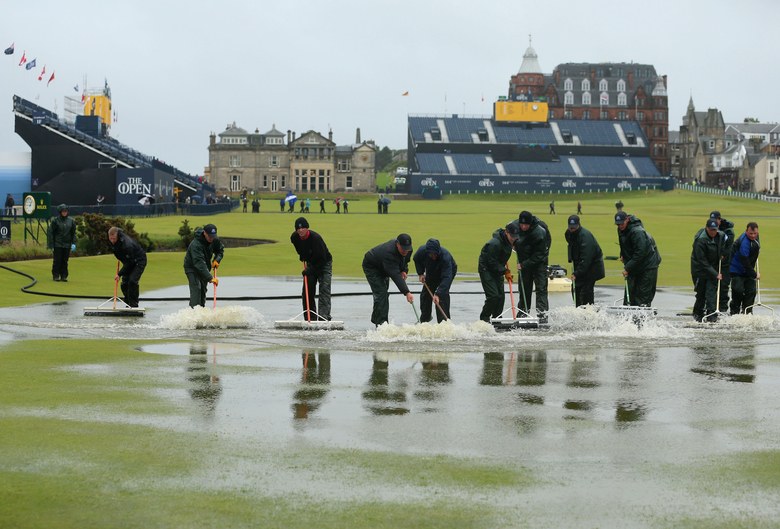Andrew Redington/Getty Images
Staff clear the course of water after heavy rainfall prior to the second round of the 2015 Open Championship at the Old Course at St. Andrews.
By Ryan Herrington
A future without the Old Course at St. Andrews? Or Royal Troon? According to a new report, it’s a reality golf fans could potentially face in the wake of data about the impact of global warming.
The Climate Coalition, which represents more than 130 organizations in the United Kingdom studying the effects of climate change, released a paper titled “Game Changer: How climate change is impacting sports in the U.K.” In it, the group makes the case that rising temperatures can and will have a detrimental impact on some of the area’s most popular pastimes, including golf, soccer, skiing and cricket.
According to the report, six of the seven wettest years on record in the U.K. have taken place since 2000. Citing new rainfall patterns, rising sea levels and increased storm surges, the report states that golf courses along the coasts are already dealing with the adverse effects of erosion and will continue to be faced with issues down the road.
“Unchecked, the impacts of climate change could significantly affect the sport over the long term, particularly in Scotland,” the report states, noting that one in six of Scotland’s 600 courses are located on the coast.
The report mentions by name the Old Course at St. Andrews, the iconic Home of Golf and Open Championship venue, and Royal Troon, another cherished venue in the Open rota, as vulnerable. Other seaside courses in the U.K. that host the Open include Royal Birkdale, Royal Liverpool, Royal Lytham & St. Annes, Muirfield, Royal St. George’s, and Turnberry.
Related: What we saw during an early visit to Carnoustie as it preps for this year’s Open
The Climate Coalition used Montrose Links as a case study. The first reference to golf being played at there was in 1562. In the last 30 years, however, the North Sea has crept 70 meters closer to the course, according to research published by Dundee University.
“As the sea rises and the coast falls away, we’re left with nowhere to go,” Chris Curnin, director of golf at Montrose, is quoted in the report. “Climate change is often seen as tomorrow’s problem, but it’s already eating away at our course.”
Cumin notes that in 2017 a rock armour protecting the first green and second tee would no longer suffice in a severe storm. The course, with the help of the local council, was forced to take rocks from near the third tee and move them to the armour to help fortify the area and prevent a major storm from doing significant damage to the course.
The report quotes Steve Issac, the R&A’s director of sustainability, about growing concerns for the sport.
“It [climate change] is certainly becoming a factor,” Isaac says. “Golf is impacted by climate change more than most other sports. Trends associated with climate change are resulting in periods of course closures, even during summer, with disruption seen to some professional tournaments. We are witnessing different types and timings of disease, pest and weed outbreaks. The future threats are very real, with course managers having to show adaptation if we are to maintain current standards of course condition. It is something we take very seriously.”









